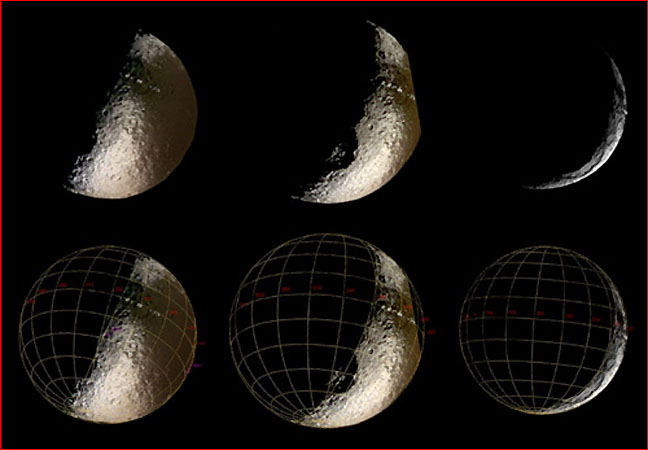|
|
||
 Credit: NASA/JPL/Space Science Institute |
||
|
pic of the day Links:
Society for
|
Dec
20, 2004 Iapetus is the eighth moon of Saturn. Its rotation is phase-locked with its revolution, so the same side always faces forward in its orbit around Saturn. It also means that one side (called the leading side) is the "front side" -- it leads Iapetus' motion around Saturn and the opposite side (called the trailing side) is the "back side". The leading side is dark, but the trailing side is light, so much so that Cassini, the astronomer who discovered the moon in 1671, remarked that he could see it on one side of Saturn but not on the other. Of all the moons in the solar system, Iapetus is the only one that is "half-and-half". Now the giant Aericebo Radio observatory (backdrop for many high-tech action scenes in the movies), has "looked" at Iapetus with its radar "eye" and has "seen" a uniformly bright surface instead of the half-and-half view that our telescopes show. The bright side of Iapetus is darker in radar than in visible light, while the dark side is lighter. Astronomers are surprised. Why?Astronomers are trained to understand how their instruments work and to calibrate them before using them. But they are not trained to understand, and are often not even aware of, the primary instrument used to make sense of their "scientific sensations": mental processes. They expected Iapetus to be half-and-half because for over three centuries they had seen that it was half-and-half. They took for granted the assumption of naive realism that "what we see is what's there." But this naive realism overlooks several fundamental realities:
Our theories are not so much descriptions of "what is" as they are interpretations of sensory-cognitive experiences. They are, in a broad sense, metaphors: There can be more than one that's true; each one will in turn alter the experiences it interprets; and the altered experiences will require new interpretations. The real world is not composed of immutable objects we occasionally bump into and consequently experience but rather is composed of our experiences that we consequently interpret as objects. Now that we have instruments that do detect electricity and can translate what they "sense" into human-sensible forms (meter-needle deflections, numerical read-outs, etc.), what's surprising is how tenaciously we cling to old mechanical explanations and try to force the new "sensations" into the old sensory categories and theories. The naive presumption that Iapetus "is" half dark and half light must be "calibrated" with reference to which "eye" is looking at it. The "real object out there" of naive objectivism is only one of many possible gestalts of seeing and thinking. It works well for making sense of our daily experiences, which have little to do with the electrical behavior of plasma. But off the surface of the Earth, in the domain of Iapetus, plasma dominates. As we acquire new "eyes" that can "see" plasma and new viewpoints that are immersed in plasma, the "objects" that explain our new experiences will metamorphose. Our electric "eyes" tell us the universe is 99 percent plasma. But scientific thought is still 99 percent mechanical. We should not expect our anthropo- and geo-centric explanations to survive space-age changes in our "eyes" and viewpoints. To paraphrase Heraclitus: It is the thunderbolt that will steer our theories.
|
|
|
Copyright 2004: thunderbolts.info |
||
